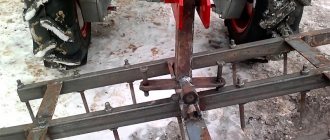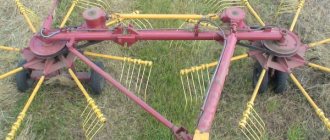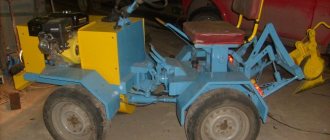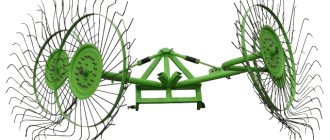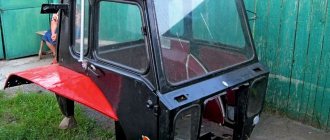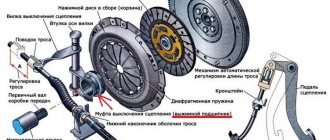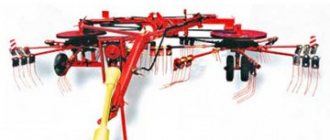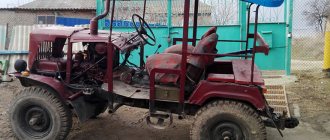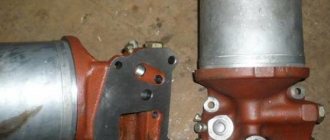Raising livestock requires quite a lot of feed, such as hay and a variety of grasses. However, to grow, mow and harvest them yourself, you will also need a variety of devices, which together can cost quite a pretty penny. The solution may be to independently manufacture certain equipment, for which improvised materials and even what previously might have seemed like garbage are often suitable.
Application of tedder rakes
After mowing, you should prepare the grass for turning it into hay. This means that it is necessary to form windrows, turn over from time to time, and collect into bales or rolls. Factory or homemade tedder rakes collect the mown grass into windrows and, if necessary, turn them over to dry. To use hay harvesting equipment, walk-behind tractors, mini tractors, tractors and even horses are used. This is much more efficient than working with hand tools. You can perform the following operations:
- raking of mown plant matter;
- tedding the grass;
- windrow wrapping and spreading;
- doubling of arranged rows of rolls.
Do-it-yourself rakes for mini tractors have a number of advantages. The device is more efficient than hand tools, is easily transported to the storage area and takes up little space. Affordable price and no problems purchasing spare parts.
All tedders can be divided into several types. For example, rakes differ in the rotation of the working elements when forming transverse and lateral rolls. They are also divided according to the type of working mechanisms:
- wheel-finger, allowing you to make rolls of the required size. This type can only work with dry plant mass and this is perhaps the only drawback. Thanks to the thoughtful design of the rake, tedders of this type are characterized by good performance and are considered the most practical;
- drum or rotary, characterized by structural strength and independent arrangement of raking wheels. They are considered the most expensive models on the agricultural equipment market, but this is justified by their functionality. This type of equipment can not only turn over the mown plant mass, but also form neat windrows from it;
- tooth tedders. Thanks to the design, it is possible to change the angles of inclination of the working elements.
Depending on the type of traction, the equipment can be either tractor or horse. The second type can be used together with a walk-behind tractor. Installation of factory or homemade rakes is possible in three ways:
- trailed (installed on tractors);
- semi-mounted rakes (the most affordable);
- mounted tedders (aggregated with walk-behind tractors and mini tractors).
Rotary tedders are considered the most expensive, so many people prefer to do it themselves, especially since there are no problems with spare parts. They can be purchased in specialized stores or removed from old equipment. Making your own rake is not that difficult; all you need is the desire and experience in handling a plumbing tool.
Varieties for mini tractors
There are many options for homemade and factory rakes for tractors. The classification is based on characteristics such as the type of working mechanism, method of attachment to the machine, etc.
By type of working mechanisms:
| Name | Characteristic |
| Wheel-finger | They are characterized by high productivity and can make windrows of the required size. |
| Rotary | Durable and multifunctional. In addition to creating windrows, they are used for turning hay. |
| Dental | Can change the angle of inclination. |
By type of traction:
- tractor;
- horse ones, can also be attached to a walk-behind tractor.
According to the installation method, devices are divided into:
- mounted;
- trailed;
- semi-mounted.
However, the main criterion is the design. According to this principle, rakes are divided:
- rotary;
- wheel-mounted;
- tape
Types of tedders
The most commonly used type is a hay rake. To harvest it, you need a tool that performs tasks such as raking grass, turning and collecting hay into windrows. These universal tools are turners, which are divided into groups:
- by the nature of manufacturing of the working part;
- by type of traction;
- according to the method of formation of wolves;
- by type of fastening.
By type, such devices for tractors can be divided into two parts:
Tedders Sunshine for a mini tractor
- wheel-mounted (for example, Solnyshko tedder rake);
- rotary.
Wheeled ones usually have 3-5 built-in wheels, located obliquely from each other. This increases overall labor productivity. Using the mounted rake of the tedder increases both the gripping area and the thoroughness of raking the grass, and, accordingly, the speed of work as a whole. A simplified repair of the wheelbase is noted in Solnyshka - tractor tedders and rakes have interchangeable wheels secured by two bearings. The most popular among Solnyshko tedders are the GVK tedder rakes, which allow you to rake windrows on both sides at once and turn hay.
Important Technical characteristics and configuration options for the MAZ-103 bus
Among the advantages of the Solnyshko tedders are:
- low level of labor costs for servicing the mechanism;
- mounted tedder rake ensures longer service life;
- have a powerful traction drawbar and frame (more relevant to factory production);
- convenient transfer of the unit to the working or transport position, which is implemented through the hydraulic system by the tractor operator;
- Convenience of adjusting the pressure of the drive wheels.
Tedders for walk-behind tractor
Rotary tedder rake includes horizontally located disks (rotors) that are connected to the engine and rotate under the influence of the PTO. Metal pipes with fingers made of iron rods are attached to the rotors. Like tractor rakes, rotary tedders do their “duties” well, but they also have specialization. Their specific direction is collecting hay into compact windrows.
There are also cross tractor rakes. They belong to the mounted type of turners. Transverse devices are designed for raking freshly cut grass with a wide grip. On average, the grip of such instruments is 12-15 meters. to menu
Drawings and assembly instructions
Assembling the device with your own hands is a doable task even without special knowledge.
Mounted wheeled
We are talking about “sun” type rakes, which are so called because of the tedder wheels located on both sides of the mini tractor. The advantages of the design are the speed of raking and turning hay, as well as a long service life. In total, 3-5 wheels are placed on the “sun”.
For assembly you will need:
- grinder, drill, wrenches, welding and other tools;
- metal pipe (you can use a motorcycle frame);
- thick wire to form the fingers of the instrument;
- brackets;
- sheets of metal, such as steel, to make discs;
- bearings: 2 per wheel;
- spare parts for the fastening device to attach the tedders to the tractor (for example, car hubs).
According to the drawing, you need to assemble the parts into one structure, then attach the “sun” to the tractor.
Tape design
This tool is suitable for collecting and tedding freshly cut grass and hay.
A distinctive feature of tedders is the extensive coverage of the treated area with a low weight of the implement.
Since there are no wheels in the design, the rake is considered to be mounted.
Rotary rake
Farmers use them to collect and form windrows of fragile types of hay. The “fingers” gently beat and turn the crops, maintaining the quality of the grass without loss of mass.
For assembly you will need:
- metal pipes with a diameter of about 5 cm and rods - 1 cm;
- metal for frame;
- chain and gears;
- metal sheet for strengthening;
- cardan shaft
Build process:
- Preparing the frame. Its width should be suitable for the mount, and its length should be suitable for the grip radius. For example, with a span of 3.5 m, the length of the frame will be 2.5 m. The shape that works best is a crane boom, i.e. at one end it is wide, and at the other it narrows.
- Preparing the rotor. It will be driven by a cardan shaft, which is used as the rear axles of cars (since they have the necessary gears).
- Attach pipes about 40 cm long to the rotor. To do this, you need to drill holes for them at equal distances in diameter.
- Make rake “fingers” from rods, secure them to the pipes with bolts or weld them.
- Attach the rotor to the frame. In order for the design to work correctly, you need to adjust the gears for raking and tedding. The shaft must be divided in half and the parts placed on opposite sides so that the rotation speed is reduced to 80 and 20 rpm, respectively.
- Attach one part to the frame using plates with bearings.
- The second one is to be attached to the bottom with springs. Place the gears on the shaft and connect them with a chain.
To change gears, the worker will need to change the gear and chain length.
Rakes for tractors - varieties, do it yourself
Rakes have always been a necessary hand tool for homeowners. Virtually no land work could be done without their help. They could rake up garbage or mown grass, break clods of earth, and level beds. But their main purpose, then and now, concerns drying and harvesting hay.
With the introduction of technological progress in agriculture, even drying and harvesting hay has ceased to be hard manual labor. With the help of tractor-mounted hay rakes, these labor-intensive processes will no longer take so much time. Let's take a closer look at this type of attachment.
Types of rakes for tractors
Tractor rakes for hay have the same purpose as manual ones - turning over, raking grass, forming windrows of hay.
They can be classified according to different parameters - by the type of working mechanism, by the method of fastening and traction, by the method of forming rolls, etc.
But still, the main criterion by which tractor rakes differ is their design. There are 3 types of rakes:
Wheel mounted rakes for tractor
This includes the “Sun” type rake, popular among users, which is suitable for mini tractors and heavy implements.
The design allows you to quickly and efficiently turn and rake hay on both sides of the unit. The design provides from 3 to 5 or more tedder impellers.
Also, the advantages of this type of rake for a tractor include:
- ease of use and ease of repair, long service life;
- power and performance;
- The adjustment is hydraulic, the operator can easily and comfortably control the working position of the hitch.
Rotary windrow rake
They operate from the power take-off shaft.
The design is a horizontal disk with metal pipes onto which fingers made of steel rods are attached.
Compared to the previous species, they have a slightly limited specialization - collecting hay and forming windrows. Although the hay also moves during the process, air circulation improves.
Also, this type of tractor rake is more suitable for fragile types of hay that require careful care (for example, alfalfa).
Belt rake for tractor
More productive and technologically advanced units.
Designed for collecting and turning freshly cut grass and hay. Suitable for tractors with power from 20 HP. s., productivity – about 1.5 ha/hour.
How to make a rake for a tractor?
Making a rake for a tractor with your own hands is not that difficult. A homemade design will differ from the factory one in parameters that are ideally selected for your conditions of use.
Before starting production, you should decide on the type of future equipment (wheeled or rotary rakes). First of all, the choice will depend on the type of terrain. Rotary rakes are suitable for flat terrain, as they work at a certain height.
On hilly, uneven surfaces it will be easier to work with a wheeled adjustable rake.
You should also acquire drawings, tools and necessary supplies.
Drawing of a wheeled rake of the “Sun” type
To make a wheeled rake of the “Sun” type you will need:
- tools - welding, grinder, wrenches, drill, measuring tools, etc.;
- metal pipes for the frame (you can take a ready-made frame from an old motorcycle);
- wheel brackets;
- wire about 6 mm thick for making raking fingers;
- metal sheets about 4 mm thick for making working disks;
- wheel bearings;
- spare parts for the manufacture of a device for attaching to a tractor.
The hubs from the car are suitable for mounting the wheels. Then it’s just a matter of small things – fastening all the parts together and connecting the equipment to the tractor. The video below demonstrates the working capabilities of homemade rakes of this type on a KhTZ tractor:
To make a rotary rake for a tractor, you will need the following materials:
- metal rods with a diameter of about 1 cm;
- pipes with an outer and inner diameter of 5 cm;
- metal profile for frame;
- cardan shaft;
- a set of gears and chains;
- sheet of metal about 5 mm thick (to strengthen the structure).
The manufacturing process begins with the assembly of the frame. The width will depend on the attachment to the tractor, the length - on the working grip of the rake. You can use the rear axle from a car as a rotor. It is ideal, if only because there are already gears inside to transmit movement. Before installation, you still need to cut off the gearbox and weld the differential.
For the rotor, a disk from a car is suitable, onto which 10 pipes are welded from the center. We reinforce them with plates. The length of the pipes should be about 40 cm. We insert pipes with an outer diameter of 5 cm into them. We make holes to adjust the length, and connect the pipes using a bolt to fix them. Next, the rake itself is made and secured from the rods.
To reduce the speed from the PTO, the central shaft is divided into 2 parts and shifted at the same angle up and down. On the tractor side, the shaft is attached to the frame using a plate with bearings.
The second half is pulled to the bottom of the body by springs, and horizontal travel stops are made from pipes on the sides. Gears are put on the shaft and connected by a chain. The spring will allow you to easily change the chain, despite the difference in gear diameters.
General recommendations
Farmers are choosing to assemble their own rakes to save money. However, it is worth considering that spending on homemade tedders will be less only if there is a sufficient amount of scrap metal, i.e. in the absence of the need to purchase consumables. As a result, structures assembled with your own hands last a long time, and their power is not inferior to factory-made devices.
The main recommendation is to decide which type of tool is most suitable for the area of land being cultivated. Since, for example, sun rakes and tedders with a belt structure will work effectively only on flat fields.
In addition, it is worth thinking about the choice of design device, because... rotary devices are one spinning wheel, which can be hazardous due to the large radius of rotation.
How to set up a plow on a mini tractor
Homemade cutter for t 40
Harrow for mini tractor
Hiller for mini tractor
The best mini tractors for snow removal with a bucket: how to make a snow blower yourself
How to make a PTO for a homemade mini tractor: diagram, instructions
This is interesting: Description of a manual seeder for carrots
Do-it-yourself tractor rake – Special equipment
Raising livestock requires quite a lot of feed, such as hay and a variety of grasses.
However, to grow, mow and harvest them yourself, you will also need a variety of devices, which together can cost quite a pretty penny.
The solution may be to independently manufacture certain equipment, for which improvised materials and even what previously might have seemed like garbage are often suitable.
A rotary rake for the T-25 or T-40 tractor is quite a useful tool when harvesting hay and various grasses, namely when raking swaths into equal windrows, wrapping, light tedding, or scattering and doubling windrows.
Although a homemade design may have a number of limitations caused by the manufacturer’s plumbing skills or available materials, it will help you save a lot. Also, based on your own needs, you can choose the width of the rake or set limiters to select the size of the windrow.
Depending on the topography of the field, it is worth considering two options, namely fully mounted equipment or a rotary rake with its own axis, which will allow the rake to always be at the same distance from the ground.
Tractor rakes are an indispensable assistant when making hay
Tractor rake Kverneland Taarup 95150 C
Tractor rakes are necessary for raking hay into windrows. When preparing feed for livestock, this equipment can provide invaluable assistance to the farmer.
It is worth noting that almost anyone can make a tractor hay rake with their own hands. Considering these features, every zealous owner should acquire such a unit.
In this article we will look at the design features, make a brief overview of the models and tell you how you can make a hay rake with your own hands.
Kinds
All tedders can be divided into several types. For example, rakes differ in the rotation of the working elements when forming transverse and lateral rolls. They are also divided according to the type of working mechanisms:
- wheel-finger, allowing you to make rolls of the required size. This type can only work with dry plant mass and this is perhaps the only drawback. Thanks to the thoughtful design of the rake, tedders of this type are characterized by good performance and are considered the most practical;
- drum or rotary, characterized by structural strength and independent arrangement of raking wheels. They are considered the most expensive models on the agricultural equipment market, but this is justified by their functionality. This type of equipment can not only turn over the mown plant mass, but also form neat windrows from it;
- tooth tedders. Thanks to the design, it is possible to change the angles of inclination of the working elements.
Depending on the type of traction, the equipment can be either tractor or horse. The second type can be used together with a walk-behind tractor. Installation of factory or homemade rakes is possible in three ways:
- trailed (installed on tractors);
- semi-mounted rakes (the most affordable);
- mounted tedders (aggregated with walk-behind tractors and mini tractors).
Rotary tedders are considered the most expensive, so many people prefer to do it themselves, especially since there are no problems with spare parts. They can be purchased in specialized stores or removed from old equipment. Making your own rake is not that difficult; all you need is the desire and experience in handling a plumbing tool.
How to make a rake on a mini tractor
Making hay harvesting equipment yourself is not difficult. Such equipment is perfect for farmers who own small plots of land and mini tractors. The presented version is designed for use in coupling with mini-equipment and is equipped with 5 raking wheels. Before you make a tractor rake with your own hands, you need to prepare the following materials:
Drawings and approximate dimensions.
- metal pipe (often an old motorcycle frame is used);
- brackets for mounting wheels;
- spring steel wire 4-8 mm thick for raking fingers;
- steel sheets for the manufacture of impeller disks;
- 2 bearings in the hubs for each wheel;
- parts for making a hitch for attaching a do-it-yourself tedder to the power plant.
How to make a harrow for a mini tractor with your own hands?
A harrow for a mini tractor is a very useful and multifunctional mechanism in agriculture. A disc harrow for a mini tractor can be called a universal assistant for cultivating soil, because it simultaneously performs the functions of a plow, a conventional harrow, and a cultivator. With its help, the soil is leveled and loosened, moisture is revealed before sowing, and the remains of plant roots and stems are crushed.
The structure consists of a number of disks attached at an angle to the bearing axis. The depth of immersion of discs into the soil is adjustable. The diameters of the discs also differ - from 11 to 25 cm, depending on the purpose.
Another type of harrow is a toothed (mesh) harrow. This is an older and time-tested option. The design is a network of thin metal plates with teeth of various shapes (straight, curved, spring harrows for a mini tractor). The functionality and efficiency of such a harrow is significantly limited compared to a disc harrow.
You should make your own disc harrow for a mini tractor using the following algorithm:
- A harrow frame is made from pipes and a square metal profile. The width of the frame should be about 1 m so that the structure does not turn out to be too massive and heavy.
- A shaft of the appropriate diameter is attached in the central part, which is additionally reinforced with racks. The shaft can be used from an old cultivator.
- Discs of the appropriate diameter (about 25 cm) are installed on the shaft.
- The number of disks should be in pairs on the left and right sides of the structure. The discs are installed at a slight angle to the shaft at a distance of about 5 cm from each other.
- To increase the productivity of the harrow, cuts are made on the disks in a semicircle using a grinder.
This design is ideal even for a light mini tractor with a VAZ engine.
Required material and tools
First, you need to take care of the availability of tools, since all further work will depend on this. First of all, you need a welding machine, an angle grinder, an adjustable wrench and a drill with a metal drill. If there should be no problems with cutting metal, then quality welds will require skill. The rotor will rotate at fairly high speeds, and if it breaks, it can damage the tractor or create a dangerous situation for human life.
For the homemade rotary rake itself, you will need metal rods 10 mm wide for the tractor, tubes with an outer diameter of 50 mm and an inner diameter of 50 mm, you can also choose a metal profile for the frame. Next, you need a driveshaft, or rather, its articulated part, as well as a set of gears and a chain, which will be described later. For various works on strengthening the structure and the like, sheet steel 5 mm thick is required. For the rotor itself, the rear axle assembly of the car is best suited, and the presence of a native driveshaft will only be for the better.
Photo of homemade rotary rake for tractor T-25
How to make a harrow for a mini tractor with your own hands?
Based on the above, a universal option is a disc harrow for a mini tractor.
You can make a homemade harrow quickly and easily using the following algorithm:
- Make a frame. Pipes and metal profiles are suitable as blanks. You should not make the frame too large and massive, so as not to overload the mini tractor.
- A shaft is fixed in the center of the frame, which is reinforced with racks. The diameter is selected based on the size of the disks.
- The discs are attached to the shaft at a slight angle, at a distance of 5-7 cm from each other. The disks should be placed symmetrically. Diameter – at least 25 cm.
- It is also worth making small cuts on the edges of the disks with a grinder to increase work efficiency.
Advantages
The simplicity and strength of the tedder design make it possible to use this type of hay harvesting equipment on almost any soil. The rake teeth and most parts of the unit are made of durable spring steel, thanks to which the rake can work even after being hit by stones. Even self-made mounted tedder rakes on a tractor allow you to efficiently and carefully collect the mown dry plant mass and place it in even hay windrows. The most popular are the “Solnyshko” tedders. This is due to a number of advantages:
- minimal equipment maintenance costs;
- the hinged design ensures a long service life;
- the design has a powerful frame and traction drawbar;
- convenient transfer of equipment to transport or working condition;
- price.
Most farmers claim that thanks to the use of rotary rakes and tedders aggregated with mini-tractors, the loss of dried plant matter during raking is minimized. In addition, the “fingers” on the turner wheels not only beat the hay well, but also turn it over, which improves the ventilation of the windrows and, accordingly, increases the quality of the hay mass.
Technical capabilities of the device
The most important advantage of the unit is that its maintenance and operation are carried out by one operator. Other features include the absence of complex parts and the independent installation of component parts of the equipment, so repairs in the event of unexpected breakdowns can be carried out directly in the field. Another advantage of tedder rakes is the ability to connect windrows, tedding, shaking and airing them, which contributes to high-quality pressing into bales. The capabilities of rotary rakes allow them to carefully handle crops, as well as successfully collect wet hay.
Note! The operation of wheeled tedders is characterized by high productivity and good speed. They work especially well on straight, level areas. Such machines are good for use when harvesting hay from forage crops.
Another design that resembles the sun, a do-it-yourself tedder rake, can be made for small-sized equipment (mini tractor or MTZ walk-behind tractor).
Features of equipment designs
According to the model type, tedder rakes can be used on tractors, mini tractors and walk-behind tractors. During operation they are operated by one person. According to their technical characteristics, they are classified according to the following parameters:
- By type of traction they are divided into tractor (for tractors) and horse-drawn (for walk-behind tractors);
- according to the method of collecting hay in windrows - transverse and lateral;
- by design (geared, wheel-finger and drum);
- according to the method of attachment to the equipment.
Due to its shape and appearance, the structure is called the “sun” due to the similarity of the rotor tubes to the sun’s rays. There are many models of tedder rakes in factory production, but the most popular are rotary and wheeled.
Rake tedder 5 wheels
Rotary rakes are designed in such a way that their basis is one wheel with rotor pipes, on which pin tubes are secured with springs. With the help of these devices, types of work such as tedding and drying grass are carried out. But they are not suitable for windrow collection. The rake is mounted on wheeled tractors and operates using the machine's hydraulic system.
Wheeled tractor tedders are a model consisting of several (4-5) “floating” wheels mounted on a suspension. This type of design makes it possible to work on fields with different terrain. Rotary and wheeled tedders can be used on all types of agricultural machines. Therefore, they often make roller rakes with their own hands.
Interesting. Replacing manual labor using simple rakes with mechanical tedders allows you to increase efficiency tenfold.
The principle of operation of the design
The operation of the equipment is based on the transmission of the rotational motion of the tractor or walk-behind tractor engine to the rake mechanism. This allows you to use up to five pairs of wheels and carry out hay harvesting over a large area. Using special devices on wheels that resemble large hooks, you can perform several types of work: prying up armfuls of grass or shocks of straw, turning over or raking.
Everything will depend on the setting of the angle of the needle wheels. This will allow you to combine or vary the functions of the machine. You can set the rake so that it collects grass in the center or, conversely, arranges it in a row to collect hay from the front. Thanks to the simple operating principle of the unit, it will be easy to work with. Therefore, it will not be difficult for a self-taught craftsman to make a homemade rake for harvesting hay for a tractor with his own hands.
Mounted tedder rake
Design and features of mounted tedder rake
A hay tedder for a tractor, which performs several important agricultural tasks at once, is a very popular tool. Therefore, agricultural machinery manufacturers pay quite a lot of attention to the design and manufacture of this mounted element. The hay rake for the tractor is available in various modifications and types. However, two are in greatest demand:
- Rotary. This is a wheel-finger design with a base of thickened rotor pipes. Fingers are attached to horizontally rotating rotors using a spring with teeth for collecting hay and turning over dry grass. Moreover, the operator can easily control the height and angle of rotation of the rake, which in turn ensures an even load on the device and good reproduction of the terrain of the area.
- Wheeled. This type of rake is a mounted wheeled structure with 3-5 wheels mounted on a floating console, located obliquely from each other. Bent wire spring fingers are installed on them, which rake/turn over the hay. The floating suspension guarantees good shock absorption and prevents premature wear of agricultural implements.
Installing a rake on a tractor, regardless of the selected device model, significantly increases the productivity and speed of hay harvesting.
Description of the tool
Windrowing is one of the main stages of hay harvesting. Therefore, the demand for tedder rakes that effectively carry out this operation is constantly growing. To date, several types and modifications of similar equipment for tractors have been developed. The most popular types are rotary and wheeled mounted models.
Tractor rotary tedders are a wheel-finger structure, the basis of which is thickened rotor pipes. The hay raking fingers are attached to these horizontally rotating rotors using springs with several teeth. This ensures uniform load on the device and good reproduction of the topography of the treated area.
Torque is transmitted to the rotors through cardan-type joints like car joints, which ensures equality of angular velocities. The drive is smooth and has protection against spontaneous starting during transportation. This type of tractor tedders has the ability to adjust the tedding height and angle of attack. They do not have their own power and are mounted on a wheeled tractor, working through a hydraulic system and a power take-off shaft.
Wheel rakes are a tractor-mounted structure made of floating wheels mounted on a console. They are equipped with bent wire fingers-springs for turning hay. Since outwardly such a device resembles a sun drawn by a child’s hand, this is the popular name these tractor tedders received.
The efficiency of their operation is increased due to the fact that the wheels are located at an angle relative to the direction of movement of the tractor and somewhat overlap each other’s rotation zones. The floating suspension provides excellent shock absorption, so the tedder copes well with uneven terrain, easily overcoming irrigation canals and embankments. Its wheels are interchangeable and each of them is mounted on two bearings, which increases the service life of the device and facilitates repairs. The wheels rotate independently and are carried out through a cardan, chain or belt drive. Therefore, such tedder rakes can be used as attachments for a tractor, mini tractor or walk-behind tractor.
Depending on the tractor model, devices with four and five wheels are available. The only difference between them is the working width, which determines the speed and productivity of tedding and raking the mown vegetation into windrows on a field of the same size. Also, such rake tedders are often made by hand. As a rule, these homemade devices are designed to be mounted on a small tractor or walk-behind tractor used on the farm.

